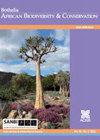INFLUENZA REQUIERE UN MANEJO BAJO LA PERSPECTIVA DE “ONE HEALTH” EN COLOMBIA.
IF 0.5
4区 生物学
Q4 PLANT SCIENCES
引用次数: 2
Abstract
Influenza is an important viral disease of worldwide distribution. It is caused by the Alfainfluenzavirus or influenza virus type A (IAV). A segmented ssRNA genome in the influenza viruses confers high variability and reassortment capability to the virus. That and the broad range of susceptible hosts, along with the possibility of inter-species transmission, represents a challenge to human and animal health. The IAV is able to infect a large variety of hosts such as several wild and domestic avian and mammalian species, including humans, as well as reptiles and amphibians, among others. There are 16 hemagglutinin (HA) and 9 neuraminidase (NA) subtypes recognized until know, whose main reservoir are the wild aquatic birds. In addition, two new subtypes (H17-18 and N10-11) have been recognized in bats, and these have been designated as influenza-like viruses. Taking this into account and knowing the richness of biodiversity in Colombia, there is an imperative need to study and to know about the IAV circulating in the field in order to establish risk factors and to analyze the past, the current and the future effect that climate change, sociodemographic factors and the role that different species could play in the eco-biology of this viral agent. This should be considered under the one health concept of influenza virus infection as a whole, considering the fact that Colombia is a country in which the circulation of IAV has been demonstrated in the swine and human population and there are preliminary results of the presence of Orthomyxovirus in bats.在哥伦比亚,流感需要从“一个健康”的角度进行管理。
流行性感冒是一种全球性的重要病毒性疾病。它是由甲型流感病毒或流感病毒(IAV)引起的。流感病毒的分节ssRNA基因组赋予病毒高度变异性和重组能力。这一点以及广泛的易感宿主,以及物种间传播的可能性,对人类和动物健康构成了挑战。IAV能够感染各种各样的宿主,如几种野生和家养鸟类和哺乳动物物种,包括人类,以及爬行动物和两栖动物等。目前已知的血凝素(HA)亚型有16种,神经氨酸酶(NA)亚型有9种,其主要宿主为野生水禽。此外,在蝙蝠中发现了两种新的亚型(H17-18和N10-11),它们已被指定为流感样病毒。考虑到这一点,并了解哥伦比亚生物多样性的丰富性,迫切需要研究和了解在该领域传播的IAV,以便确定风险因素,并分析气候变化、社会人口因素和不同物种在该病毒剂的生态生物学中可能发挥的作用的过去、现在和未来的影响。考虑到哥伦比亚是一个猪流感病毒在猪群和人群中传播的国家,以及在蝙蝠中存在正粘病毒的初步结果,应根据流感病毒感染的整体健康概念来考虑这一点。
本文章由计算机程序翻译,如有差异,请以英文原文为准。
求助全文
约1分钟内获得全文
求助全文
来源期刊

Bothalia
生物-植物科学
CiteScore
1.70
自引率
0.00%
发文量
12
期刊介绍:
Bothalia: African Biodiversity & Conservation is published by AOSIS for the South African National Biodiversity Institute (SANBI) and aims to disseminate knowledge, information and innovative approaches that promote and enhance the wise use and management of biodiversity in order to sustain the systems and species that support and benefit the people of Africa.
The journal was previously published as Bothalia, and had served the South African botanical community since 1921. However the expanded mandate of SANBI necessitated a broader scope for the journal, and in 2014, the subtitle, African Biodiversity & Conservation was added to reflect this change.
 求助内容:
求助内容: 应助结果提醒方式:
应助结果提醒方式:


